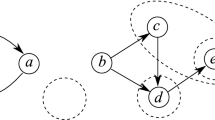Abstract
Formal proofs in mathematics and computer science are being studied because these objects can be verified by a very simple computer program. An important open problem is whether these formal proofs can be generated with an effort not much greater than writing a mathematical paper in, say, LATEX. Modern systems for proof development make the formalization of reasoning relatively easy. However, formalizing computations in such a manner that the results can be used in formal proofs is not immediate. In this paper we show how to obtain formal proofs of statements such as Prime(61) in the context of Peano arithmetic or (x+1)(x+1)=x 2+2x+1 in the context of rings. We hope that the method will help bridge the gap between the efficient systems of computer algebra and the reliable systems of proof development.
Similar content being viewed by others
References
Aspers, W. A. M., de Bakker, J. W., ten Hagen, P. J. W., Hazewinkel, M., van der Houwen, P. J., and Nieland, H. M. (eds.): Images of SMC Research 1996, Stichting Mathematisch Centrum, Amsterdam, 1996.
Barendregt, H. P.: Lambda calculi with types, in S. Abramsky, D. M. Gabbay, and T. S. E. Maibaum (eds.), Handbook of Logic in Computer Science, Vol. 2, Oxford University Press, 1992, pp. 117–309.
Barendregt, H. P.: The quest for correctness, in Aspers et al., 1996, pp. 39–58.
Boyer, R. S. and Moore, J S.: A Computational Logic, Academic Press, New York, 1988.
de Bruijn, N. G.: The mathematical language AUTOMATH, its usage and some of its extensions, in M. Laudet, D. Lacombe, and M. Schuetzenberger (eds.), Symposium on Automatic Demonstration, INRIA, Versailles, Lecture Notes in Comput. Sci. 125, Springer-Verlag, Berlin, 1970, pp. 29–61. Also in Nederpelt et al., 1994.
de Bruijn, N. G.: Reflections on Automath 1990. Also in Nederpelt et al., 1994, pp. 201–228.
Bundy, A. (ed.): CADE-12, Lecture Notes in Comput. Sci. 814, Springer-Verlag, Berlin, 1984.
Cohen, A. M.: Computers: (Ac)counting for mathematical proofs, in Aspers et al., 1996, pp. 15–38.
Constable, R. L.: Implementing Mathematics with the Nuprl Proof Development System, Prentice-Hall, Englewood Cliffs, New Jersey, 1986.
Coquand, T. and Huet, G.: The calculus of constructions, Information and Computation 76 (1988), 95–120. Available at URL: http://pauillac.inria.fr/coq/coq-eng.html.
Elbers, H.: Personal communication, 1996.
Luo, Z. and Pollack, R.: The LEGO proof development system: A user's manual, Technical Report ECS-LFCS-92-211, University of Edinburgh, 1992. LEGO system available via URL http://www.dcs.ed.ac.uk/packages/lego/.
McCarthy, J.: LISP 1.5 Programmer's Manual, MIT Press, Cambridge, MA, 1962.
Nederpelt, R. P., Geuvers, J. H., and de Vrijer, R. C. (eds.): Selected Papers on Automath, Studies in Logic 133, North-Holland, Amsterdam, 1994.
Oostdijk, M.: Proof by Calculation, Master's thesis 385, Universitaire School voor Informatica, University of Nijmegen, 1996.
Poincaré, H.: La Science et l'Hypothèse, Flammarion, Paris. 1902.
Ruys, M. P. J.: Studies in Mechanical Verification of Mathematical Proofs, Dissertation, University of Nijmegen, 1999.
Author information
Authors and Affiliations
Rights and permissions
About this article
Cite this article
Barendregt, H., Barendsen, E. Autarkic Computations in Formal Proofs. Journal of Automated Reasoning 28, 321–336 (2002). https://doi.org/10.1023/A:1015761529444
Issue Date:
DOI: https://doi.org/10.1023/A:1015761529444




